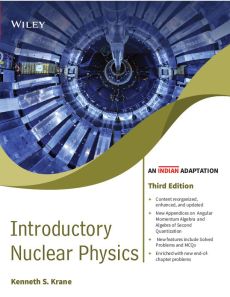Introductory Nuclear Physics, 3ed (An Indian Adaptation)
ISBN: 9789354640834
872 pages
Publication Year: 2022
For more information write to us at: acadmktg@wiley.com

Description
Krane's Introductory Nuclear Physics is a classic textbook for an introductory course for the subject, that has provided a solid foundation to undergraduate students for more than six decades. It has retained its popularity not only among physics majors but also for an introductory course by students of nuclear science and technology, nuclear chemistry, nuclear engineering, radiation biology and nuclear medicine. Structured into four units, it progressively covers nuclear sizes and shapes followed by decay and radioactivity; the third part provides a survey of nuclear reactions and their applications and part four deals with topics like particle physics, nuclear astrophysics and more.
Unit I Basic Nuclear Structure
Chapter 1 Basic Concepts
1.1 History and Overview
1.2 Rutherford’s Alpha Scattering Experiment
1.3 Some Introductory Terminology
1.4 The Fundamental Forces
1.5 Nuclear Properties
1.6 Units and Dimensions
Chapter 2 Elements of Quantum Mechanics
2.1 Quantum Behavior
2.2 Principles of Quantum Mechanics
2.3 Problems in One Dimension
2.4 Problems in Three Dimensions
2.5 Quantum Theory of Angular Momentum
2.6 Parity
2.7 Quantum Statistics
2.8 Transitions Between States
Chapter 3 Nuclear Properties
3.1 The Size of Nuclei
3.2 Mass and Abundance of Nuclides
3.3 Nuclear Binding Energy
3.4 Nuclear Angular Momentum and Parity
3.5 Nuclear Electromagnetic Moments
3.6 Nuclear Excited States
Chapter 4 The Force Between Nucleons
4.1 The Deuteron Problem
4.2 Nucleon–Nucleon Scattering
4.3 Proton–Proton and Neutron–Neutron Interactions
4.4 Properties of the Nuclear Force
4.5 Nucleon–Nucleon Interactions
4.6 The Exchange Force Model
Chapter 5 Nuclear Models
5.1 The Fermi-Gas Model
5.2 The Shell Model Preliminaries
5.3 Success of Nuclear Shell Model
5.4 Even-Z, Even-N Nuclei and Collective Structure
5.5 More Realistic Nuclear Models
Chapter 6 Nuclear Spin and Moments
6.1 Nuclear Spin
6.2 Nuclear Moments
6.3 Hyperfine Structure
6.4 Measuring Nuclear Moments
Unit II Nuclear Decay And Radioactivity
Chapter 7 Radioactive Decay
7.1 The Radioactive Decay Law
7.2 Quantum Theory of Radioactive Decays
7.3 Production and Decay of Radioactivity
7.4 Growth of Daughter Activities
7.5 Types of Decays
7.6 Natural Radioactivity
7.7 Radioactive Dating
7.8 Units for Measurement of Radiation
Chapter 8 Alpha Decay
8.1 Why α Decay Occurs
8.2 Basic α Decay Processes
8.3 α Decay Systematics
8.4 Theory of α Emission
8.5 Angular Momentum and Parity in α Decay
8.6 α Decay Spectroscopy
Chapter 9 Beta Decay
9.1 Energy Release in β Decay
9.2 Fermi Theory of β Decay
9.3 The “Classical” Experimental Tests of the Fermi Theory
9.4 Angular Momentum and Parity Selection Rules
9.5 Comparative Half-Lives and Forbidden Decays
9.6 Double-β Decay
9.7 Beta-Delayed Nucleon Emission
9.8 Nonconservation of Parity
9.9 Beta Spectroscopy
Chapter 10 Gamma Decay
10.1 Energetics of γ Decay
10.2 Classical Electromagnetic Radiation
10.3 Transition to Quantum Mechanics
10.4 Angular Momentum and Parity Selection Rules
10.5 Angular Distribution and Polarization Measurements
10.6 Internal Conversion
10.7 Lifetimes for γ Emission
10.8 Gamma-Ray Spectroscopy
10.9 Nuclear Resonance Fluorescence and the Mössbauer Effect
Chapter 11 Detecting Nuclear Radiations
11.1 Interactions of Radiation with Matter
11.2 Gas-Filled Detectors
11.3 Scintillation Detectors
11.4 Semiconductor Detectors
11.5 Counting Statistics
11.6 Energy Measurements
11.7 Coincidence Measurements and Time Resolution
11.8 Measurement of Nuclear Lifetimes
11.9 Particle Identification Detectors
Unit III Nuclear Reaction
Chapter 12 Nuclear Reactions
12.1 Types of Reactions and Conservation Laws
12.2 Kinematics of Nuclear Reactions
12.3 Isospin
12.4 Reaction Cross Sections
12.5 Experimental Techniques
12.6 Coulomb Scattering and Rutherford’s Formula
12.7 Nuclear Scattering
12.8 Scattering and Reaction Cross Sections
12.9 The Optical Model
12.10 Compound-Nucleus Reactions
12.11 Direct Reactions
12.12 Resonance Reactions
Chapter 13 Neutron Physics
13.1 Neutron Sources
13.2 Absorption and Moderation of Neutrons
13.3 Neutron Detectors
13.4 Neutron Reactions and Cross Sections
13.5 Neutron Capture
13.6 Interference and Diffraction with Neutrons
Chapter 14 Nuclear Fission
14.1 Why Nuclei Fission
14.2 Characteristics of Fission
14.3 Energy in Fission
14.4 Fission and Nuclear Structure
14.5 Controlled Fission Reactions
14.6 Fission Reactors
14.7 Radioactive Fission Products
Chapter 15 Nuclear Fusion
15.1 Basic Fusion Processes
15.2 Characteristics of Fusion
15.3 Solar Fusion
15.4 Controlled Fusion Reactors
Chapter 16 Accelerators
16.1 Electrostatic Accelerators
16.2 Cyclotron Accelerators
16.3 Synchrotrons
16.4 Linear Accelerators
16.5 Colliding-Beam Accelerators
Unit IV Extensions And Applications
Chapter 17 Particle Physics
17.1 Particle Interactions and Families
17.2 Symmetries and Conservation Laws
17.3 CP Violation in K Decay
17.4 The Quark Model
17.5 Colored Quarks and Gluons
17.6 Reactions and Decays in the Quark Model
17.7 Charm, Beauty, and Truth
17.8 Quark Dynamics
17.9 Neutrino Physics
17.10 Grand Unified Theories
Chapter 18 Nuclear Astrophysics
18.1 The Hot Big Bang Cosmology
18.2 Particle and Nuclear Interactions in the Early Universe
18.3 Primordial Nucleosynthesis
18.4 Stellar Nucleosynthesis (A ≲ 60)
18.5 Stellar Nucleosynthesis (A > 60)
18.6 Nuclear Cosmochronology
Chapter 19 Applications of Nuclear Physics
19.1 Trace Element Analysis
19.2 Mass Spectrometry with Accelerators
19.3 Alpha-Decay Applications
19.4 Diagnostic Nuclear Medicine
19.5 Therapeutic Nuclear Medicine
Appendix A Special Relativity
A.1 Lorentz Transformation
A.2 Relativistic Dynamics
A.3 Transformation of Energy and Momentum
Appendix B Center-of-Mass Reference Frame
B.1 Reaction Kinematics
B.2 Cross Sections
B.3 The CM Schrödinger Equation
Appendix C Tensor Forces and Scattering in Nucleons
C.1 Tensor Forces
C.2 Proton–Proton Scattering in Central Potential at Low Energy
C.3 Derivation of n–p and p–p Scattering at Low Energy
Appendix D Heavy-Ion Reactions
D.1 Heavy-Ion Reactions
D.2 Isospin Dependence of Heavy-Ion Reactions
Appendix E Angular Momentum Algebra
E.1 Vector Coupling Coefficients
E.2 Wigner–Eckart Theorem
Appendix F Algebra of Second Quantization
F.1 Second Quantization for Bosons
F.2 Second Quantization for Fermions
Appendix G Table of Nuclear Properties
Credits
Index

